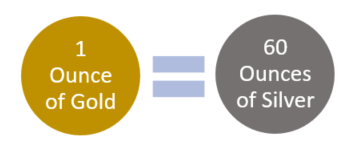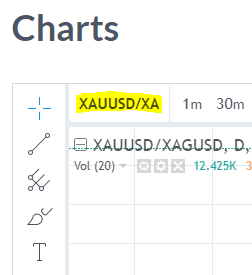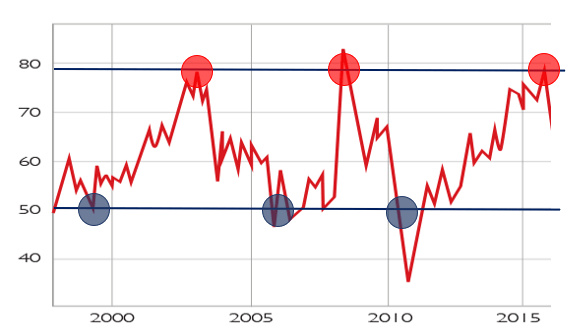The gold-silver ratio offers invaluable insight into the possible movements of the two precious metals relative to each other. Traders look to the ratio for an edge in identifying buy and sell signals in the market. Therefore, knowing how to trade the gold-silver ratio can be a huge advantage to maximize your commodities trading strategy.
WHAT IS THE GOLD-SILVER RATIO?
The gold-silver ratio is simple. It is the number of silver ounces you would need to trade to receive one ounce of gold at current market prices. For example, when gold price is trading at $1000 per ounce andsilver price is trading at $16.67 per ounce the gold-silver ratio will be equivalent to 60.

The gold to silver ratio has averaged around 60 from 2001 to 2017. With highs breaching 80 (ounces of silver to one ounce of gold) and lows sinking to around 40.
The ratio tends to increase during times of economic distress. The cause of this relationship is due to gold generally outperforming silver during recessions, leading to increases in the ratio.
The ratio peaked at 100 in 1991 when silver prices dropped to extreme lows.



RECOMMENDED BY JAMES STANLEY
Download our most recent Gold Forecast
Get My Guide
HOW THE GOLD-SILVER RATIO WORKS
When thegoldprice increases faster than thesilverprice the ratio willincrease.
When thesilverprice increases faster than thegoldprice the ratio willdecrease.
When thegoldprice decreases faster than thesilver pricethe ratio willdecrease.
When thesilverprice decreases faster than thegoldprice the ratio willincrease.

Source: Bloomberg data
The graph above shows the gold to silver ratio for the past several decades. In 1991 silver was trading at extremely low prices- causing a peak in the gold-silver ratio, denoted by the blue circle in the graph above.
It is also worth noting the spike in the ratio during the 2008 subprime-mortgage crisis, caused by surging gold prices and silver not performing as well. This is denoted by the red circle in the graph above.
HOW TO TRADE THE GOLD-SILVER RATIO
There are many ways to use the ratio to your advantage. Keep reading for the top two strategies on trading the gold-silver ratio.
1) USING THE GOLD-SILVER RATIO TO DETERMINE THE METAL WITH THE STRONGEST TREND AND TRADE IT:
Traders can use the gold-silver ratio to determine which metal may outperform the other and then place a trade accordingly.
A trader could use these five steps to enter a trade on either gold or silver using the ratio:
1) Determine the trend on a gold-silver ratio chart by adding trend lines to the chart. You can use DailyFX’s chart to view the gold-silver ratio by entering “XAUUSD/XAGUSD” in the search bar.

2) Using the time-frame of your choice, determine the trend on gold and silver individually.
3) Use this table to help you determine a bias:
| GOLD-SILVER RATIO TREND | GOLD AND SILVER TREND | SIGNAL |
|---|---|---|
| Gold-Silver RatioUptrend | Gold and silver inUptrend | Buy Gold |
| Gold-Silver RatioUptrend | Gold and Silver inDowntrend | Sell Silver |
| Gold-Silver RatioDowntrend | Gold and Silver inUptrend | Buy Silver |
| Gold-Silver RatioDowntrend | Gold and Silver inDowntrend | Sell Gold |
4) Identify trading opportunities using price action or technicalindicators time entries in the direction of the trend.
5) Identify a trade size appropriate for the account size and setstop-losses and take-profits and execute the trade.
Here’s an example using the five steps:
1) Let’s say we open our gold to silver ratio chart on 8 February 2016.We draw our trend lines and the trend lines indicate that the ratio is in a current uptrend as shown in the chart below showing a four-hourly timeframe.

2) Our next step is to determine the individual trend for gold and silver. So, we open the charts and draw our trend lines and notice that both gold and silver are trending upwards as shown in the charts below.

3) The table above indicates that when the gold-silver ratio is trending upwards and gold and silver are both in an uptrend we should buy gold because it has been outperforming silver.
| GOLD-SILVER RATIO UPTREND | GOLD AND SILVER IN UPTREND | BUY GOLD |
4) Since the beginning of February, gold has increased drastically in price. We should wait for a modest pull-back before attempting to enter the market. Once we do enter the market, we can place our stop-loss below the trend line and our take-profit above the previous high to ensure a positive risk-reward ratio on the trade.
5) We determine an appropriate trade size for our account, execute the trade and set our stop-loss and take profit.

RECOMMENDED BY JAMES STANLEY
Trading Forex News: The Strategy
Get My Guide
2) TRADING THE HIGHS AND LOWS OF THE GOLD-SILVER RATIO:
There may be times when the ratio reaches historic extremes. When it is near these points, a reversal of the ratio is at risk. For example, when the gold-silver ratio reaches for historical highs (from 80to100) the idea is that the price of gold isexpensiverelative to the price of silver. When the gold-silver ratio reaches for historical lows (from 60to40) gold is seen ascheaperrelative to silver.
Because the metals are correlated though driven by different factors, they tend to be limited in their willingness to run beyond a gold-silver ratio north of 80-100 or below 60-40, and those tend to be at turning points because the ratio has picked up on a likely abrupt turning points in markets.
The chart below shows times when the ratio was at all-time highs- red circles and all-time lows-blue circles.

Traders can use the table below as a guide to trade the metals when the gold-silver ratio at risk for a reversal:
| GOLD-SILVER RATIO EXTREME | GOLD AND SILVER TREND | TRADE SIGNAL |
|---|---|---|
| Gold-Silver RatioHistorical High | Gold and Silver inUptrend | Long Silver |
| Gold-Silver RatioHistorical High | Gold and Silver inDowntrend | Short Gold |
| Gold-Silver RatioHistorical Low | Gold and Silver inDowntrend | Short Silver |
| Gold-Silver RatioHistorical Low | Gold and Silver inUptrend | Long Gold |
It is very seldom that the gold-silver ratio reaches for these historic highs and lows, but when it does, it could offer good opportunities. Still, it is important to manage your risk because the ratio has been known to breach these historical levels.
GOLD TO SILVER RATIO TRADING: TOP TIPS
The gold to silver ratio could indicate investors’ appetite for safe-haven assets. If the gold-silver ratio is peaking, it could indicate investors are more risk-averse.
The gold to silver ratio could indicate the state of the world economy. If the ratio is at a low point, it could show that the world economy is in a growth phase.
Use the gold-silver ratio in conjunction with the individual price trends to determine the stronger trend to trade.
When the ratio approaches its historical highs -100 and historical lows -40 it is at risk for a reversal.
When making a trade, implement good habits such asincorporating a positive risk to reward ratio.
If you are unsure of the forecast for gold, readDailyFX’s quarterly forecast.






